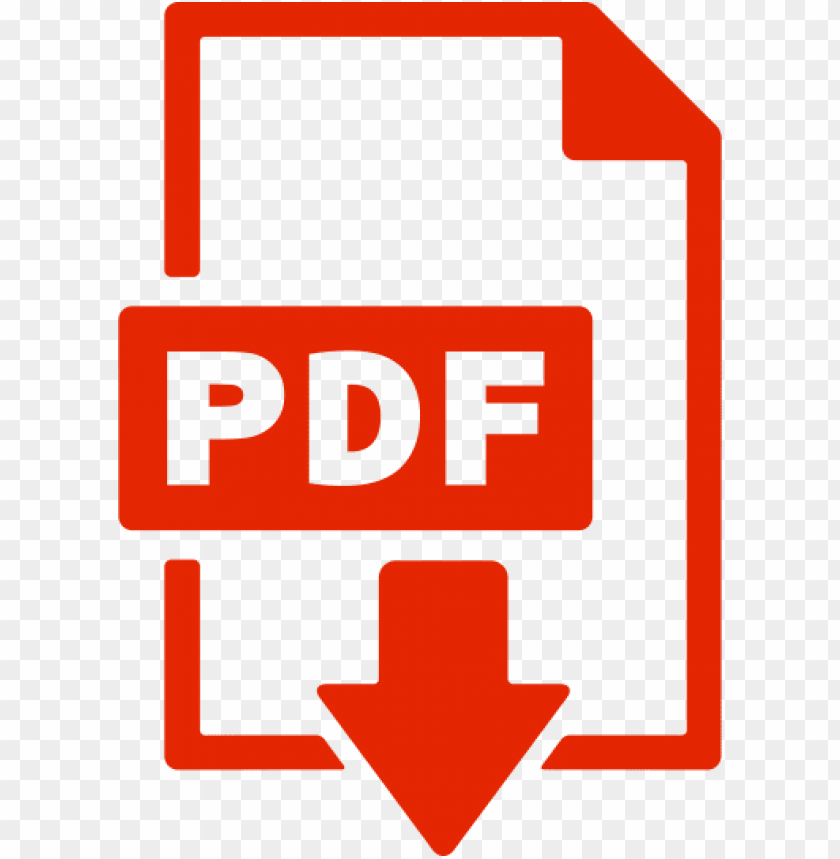August/September 2022
General Announcements
- UN-GGIM 12th Session and IAG intervention
- Opening of the Metsähovi Geodetic Research Station
- Call for Nominations for IAG Officers (2023-2027)
- Call for Nominations for the GGOS President (2023-2027)
- Survey - GGOS Strategic Plan
Meeting Announcement
IUGG General Assembly
- IUGG Berlin 2023
Meetings Calendar
IAG Sponsored Meetings
- REFAG 2022
- Unified Analysis Workshop on Laser Ranging
- 22nd International Workshop on Laser Ranging
- 20th Assembly of WEGENER
- SIRGAS Symposium 2022
- GGOS Days 2022
- IUGG Berlin 2023
Obituary
- Juhani Kakkuri (1933-2022)
- Gerd Boedecker (1944-2022)
General Announcements
UN-GGIM 12th Session and IAG intervention
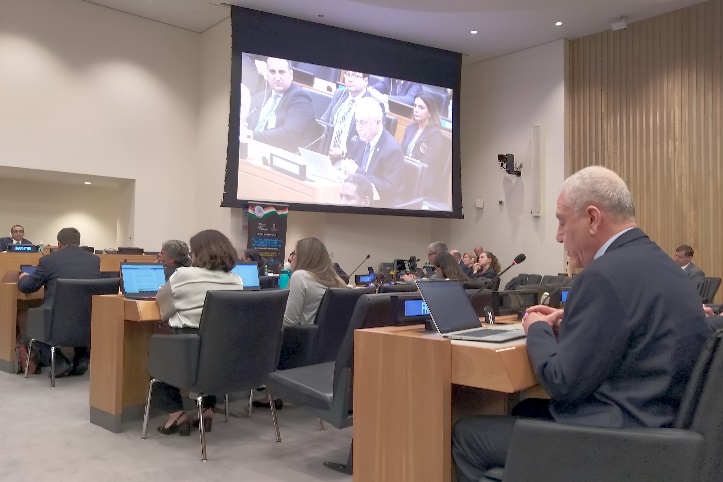
Zuheir Altamimi
President, International Association of Geodesy
Delivering the IAG intervention at the UN-GGIM 12th Session
The 12th Session of the United Nations Committee of Experts on Global Geospatial Information Management (UN-GGIM) took place from 3 - 5 August 2022 at the United Nations Headquarters in New York. Among the agenda items that were presented and discussed during the Session is the Global geodetic reference frame. The Committee of Experts welcomed the progress made by the Government of Germany and the United Nations to host and establish a Global Geodetic Centre of Excellence (GGCE) at the United Nations Campus in Bonn, Germany, later in 2022. It also encouraged the ongoing efforts of the Subcommittee on Geodesy towards developing stronger working relationships, coordination and collaboration with and between the GGCE, the International Association of Geodesy and other organizations. At this occasion the IAG President delivered the following intervention:
“The International Association of Geodesy commends the work accomplished by the Subcommittee on Geodesy during the intersessional period, and in particular its continued efforts in advocating the importance of the GGRF, as a global geodetic infrastructure for the benefit of science and society.
As the work of the Subcommittee reaches the point of implementing the ambitions of the UN GA resolution on the GGRF for sustainable development, through the creation of a Global Geodetic Center of Excellence (GGCE), IAG calls for more involvement and interaction with the Subcommittee and the GGCE, by elevating its position within the Subcommittee to a more engaging membership role.
Recalling that IAG has more than 150 years of history in bringing together geodetic institutions of Member States, and in providing fundamental geodetic products that constitute the main ingredients of the GGRF, IAG is looking forward for extensive coordination with the GGCE. In this regard, IAG is ready to take part to the GGCE activities, as a member of the International Advisory Committee.
IAG also recognizes the importance of developing communication and advocacy mechanisms to attract contributions from Member States and other relevant geodetic stakeholders to the GGCE.”
Zuheir Altamimi
IAG President
Opening of the Metsähovi Geodetic Research Station
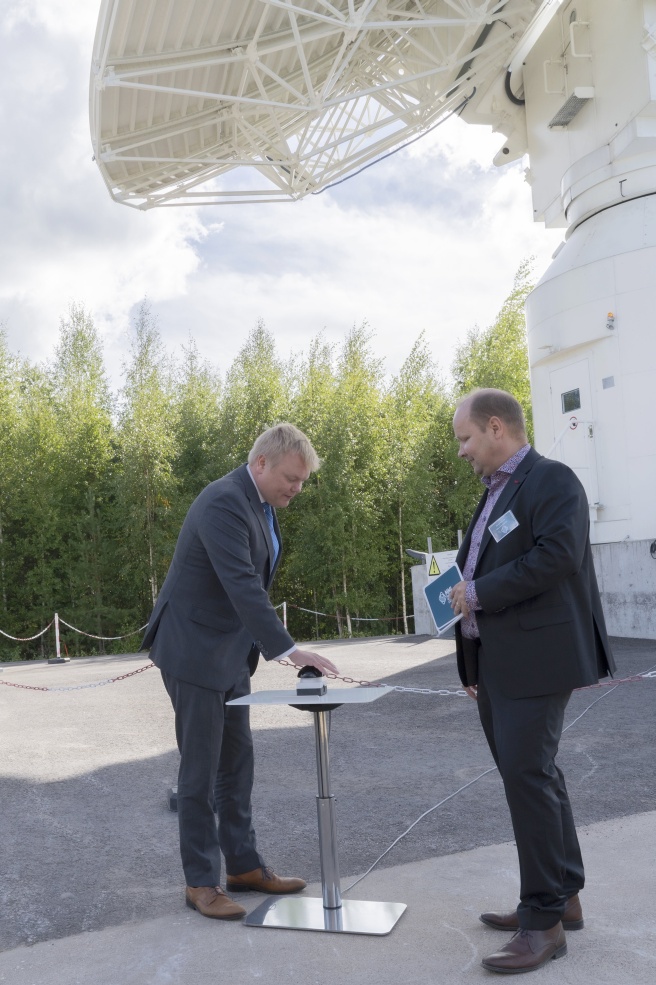
Minister of Agriculture and Forestry, Mr Antti Kurvinen
presses the button to start the VGOS telescope.
Professor Hannu Koivula follows the operation.
(Photo: NLS/Pekka Jussila)
The official opening of the upgraded Metsähovi Geodetic Research Station (MGRS) was on August 30, 2022. The station is owned by the Finnish Geospatial Research Institute (FGI) of the National Land Survey and is one of the northernmost core stations of the global geodetic network, located 60 degrees north.
The Satellite Laser Ranging observations at MGRS were started in 1978 as the first geodetic measurements at the site. Over the course of more than four decades, a gravity laboratory has been built with absolute and superconducting gravimeters, GPS/GNSS receivers added to the IGS network, and various test fields and environment-detecting instrumentation, e.g. for measuring groundwater and soil moisture were established. The reference points of the national height and gravity system are also at Metsähovi. The geodetic VLBI observations have been made since 2004 with the astronomical radio telescope of the Aalto University Metsähovi Radio Observatory in the same area. The DORIS/REGINA station, operated in collaboration with CNES, is about three kilometres away so that its radio signals do not interfere with the observations of the radio telescope.
The modernization of MGRS, started in 2012 with special funding from the Ministry of Agriculture and Forestry, includes the renewal or updating of all major measurement systems, as well as the construction of a new VGOS radio telescope system and improvement of the station infrastructure and working facilities. The renovation is now almost complete. The radio telescope and SLR equipment are still in the commissioning phase and those are expected to be completed in 2023. GNSS and gravity equipment are operational and produce data for IAG Services. Also, a pillar network and methods were developed for accurate local tie measurements between the measurement systems. From 2023, the newly established Geodetic Infrastructure Unit of the National Land Survey will be responsible for the maintenance and day-to-day operation of instruments and networks.
At the opening, the Director General of the National Land Survey, Mr Arvo Kokkonen, welcomed the guests and the "start button" of the radio telescope was pressed by the Minister of Agriculture and Forestry, Mr Antti Kurvinen.
Markku Poutanen, Hannu Koivula, Jyri Näränen
Finnish Geospatial Research Institute FGI of the National Land Survey of Finland.
e-mail: first.last@nls.fi
Call for Nominations for IAG Officers (2023-2027)
Nominating Committee
H. Schuh (Chair), schuh@gfz-potsdam.de
S. Alves, sonia.alves@ibge.gov.br
J. Bogusz, janusz.bogusz@wat.edu.pl
B. Miyahara, miyahara-b96ip@mlit.go.jp
30 June 2022
IAG Council Delegates, IAG Officers, IAG Fellows, IAG Individual Members
Dear colleagues:
As you are aware, the elections of IAG Officers for the period 2023-2027 shall take place by electronic vote before the 2023 IAG General Assembly in Berlin, Germany. The procedures for nominations and elections of Officers are given in section 39 of the IAG By-Laws. According to the IAG Statutes, Section 12, the voting members of the IAG Executive Committee that are to be elected are the following:
- President,
- Vice-President,
- Secretary General,
- Presidents of Commissions (4),
- Service representatives (3),
- Members-at-large (2), and the
- President of the Communication and Outreach Branch.
The Nominating Committee is inviting you to submit nominations as follows:
- Submit nominations for all Officer positions listed above, except for the Service representatives who will be submitted by the Services.
- All nominations should be submitted to me, electronically or by regular mail, to the address given at the end of this letter.
- The deadline to submit nominations is 31 October 2022.
Based on the nominations received, the Nomination Committee will prepare a list of candidates for each position to be filled (normally two candidates per position) and will send it to the eligible voters and nominators: IAG Council Delegates, the IAG Officers, and those IAG Fellows and Individual members who took part in the nomination process by March 2023. New nominations could be added to the list of candidates, provided they are supported by at least two IAG Council Delegates by April 2023. In April 2023 the final list of candidates will be sent out to the IAG Council Delegates for election. The result of the elections will be announced by May 2023.
The election of the two Members-at-large will be a two-step process. Candidates for the two positions will be determined after the elections for all other members of the Executive Committee have been completed. In order to ensure better geographic diversity of the IAG Officers, the slate of candidates for the positions of Members-at-large will be compiled in May2023.
This slate will then be presented to the eligible voters, and the results of the second round of lections will be announced in June 2023.
For any questions or concerns, please feel free to contact either me, or any of the other members of the Nominating Committee listed at the top of this letter.
I am looking forward to receiving your nominations and I thank you in advance for your prompt attention to this matter.
Yours truly,
Prof. Harald Schuh
Chair of the IAG Nominating Committee
GFZ German Research Centre for Geosciences
Telegrafenberg A17
14473 Potsdam
GERMANY
E-mail: schuh@gfz-potsdam.de
Call for Nominations for GGOS President (2023-2027)
Nominating Committee
B. Miyahara (chair), miyahara-b96ip@mlit.go.jp
M. Pearlman, mpearlman@cfa.harvard.edu
D. Angermann, detlef.angermann@tum.de
M. Sehnal, martin.sehnal@ggos.org
July 20, 2022
GGOS Consortium members, GGOS Coordinating Board members, GGOS Science Panel members,
Dear colleagues:
As you are aware, the elections of GGOS President for the period 2023-2027 shall take place before the 2023 IAG General Assemblyin Berlin, Germany. As given in section 15 (d) of the IAG By-Laws, "The GGOS President is elected by the IAG Executive Committee from a slate of nominations submitted by the GGOS Coordinating Board in consultation with the Executive Committee. The President is appointed for one period, which may be renewed once". The Nominating Committee is inviting you to submit nominations for the GGOS President. The deadline to submit nominations is 1st December 2022. The GGOS President is the principal spokesperson and representative of GGOS to the IAG and outside organizations, and presides over meetings of GGOS: GGOS Days Conference (annually), the Coordinating Board Meeting (1-2 times a year, usually during EGU and AGU), and Executive Committee Telecon (once a month).
Based on the nominations received, the Nomination Committee will prepare a list of candidates to be filled (normally two candidates) and will send it to the IAG Office. The result of the elections will be announced by June 2023.
For any questions or concerns, please feel free to contact either me, or any of the other members of the Nominating Committee listed at the top of this letter.
I am looking forward to receiving your nominations and I thank you in advance for your prompt attention to this matter.
Yours truly,
Basara Miyahara
Chair of the GGOS Nominating Committee
E-mail: miyahara96ip@mlit.go.jp
Survey - GGOS Strategic Plan
As GGOS reaches its 20th anniversary of service to the IAG and global geodesy community, we need your input to inform and guide the goals of the next GGOS Strategic Plan.
As the observing system of the International Association of Geodesy (IAG), the Global Geodetic Observing System (GGOS) (see details in the film “Discover GGOS”) serves a unique and critically important combination of roles – centering upon advocacy, integration, and international relations. GGOS also promotes high-level outcomes through a variety of internal and external channels. As GGOS reaches its 20th anniversary of service to the IAG and global geodesy community, we need your input to inform and guide the goals of the next GGOS Strategic Plan. Your contribution is highly appreciated.
You can see a short introduction to the survey and a video. Please participate in this survey until September 30, 2022.
Martin Sehnal
Director of GGOS
Meeting Announcement
IUGG Berlin 2023
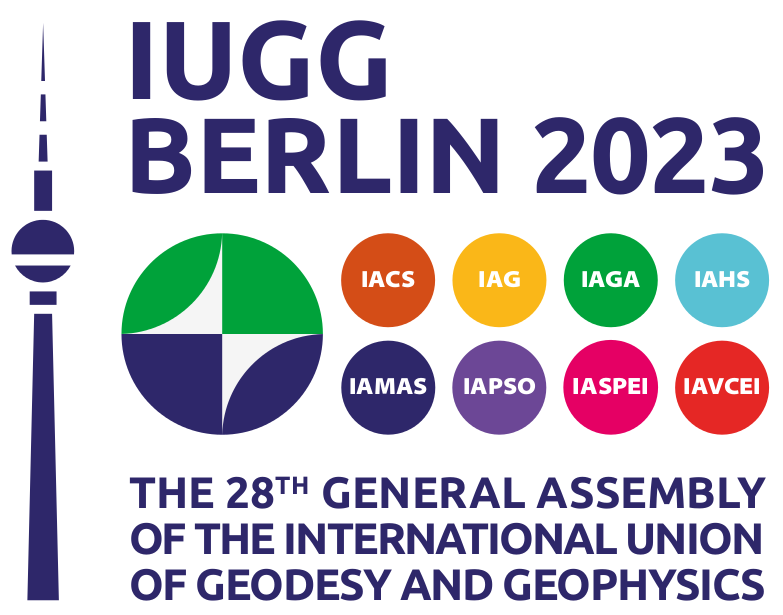
28th IUGG General Assembly (IUGG2023), Berlin, Germany, July 11-20, 2023
The 28th IUGG General Assembly (IUGG2023) will be held from 11 to 20 July 2023 at the CityCube in Berlin, Germany.
This General Assembly is a special opportunity for participants from around the world to come together and discuss the full range of geodetic and geophysical themes, and further enhance the important interdisciplinary collaboration for a better understanding of our Earth System. IUGG2023 will provide a platform for personal meetings, exchange of ideas and developing new concepts for international science collaboration, all of which have suffered a setback during this pandemic crisis. IUGG2023 will help to create a new spirit to address pressing large societal challenges such as global environmental change and natural hazards and to stimulate novel geoscience research.
Important Dates
30 September 2022
• Online registration and abstract submission opens
• Online accommodation reservations open
• Travel grant applications open
• Scientific Program Available
17 February 2023
• Closing of abstract submission
• Closing of grant application submission
17 March 2023
• Abstract/grant acceptance sent to participants
11 April 2023
• Complete scientific program and guidelines for presenters published
28 April 2023
• Early-bird registration closes
02 May 2023
• Newsletter on field trips and accommodation reservations
• Final Adjustment of program
IUGG2023 Local Organizing Committee and Scientific Program Committee
Meetings Calendar
IAG Sponsored Meetings
- REFAG 2022, October 17-21, 2022, Thessaloniki, Greece
URL: https://www.refag2022.org/ - Unified Analysis Workshop (UAW) October 22-25, 2022, Thessaloniki, Greece
URL: https://ggos.org/event/unified-analysis-workshop-uaw-2022/ - 22nd International Workshop on Laser Ranging, November 7-11, 2022, Yebes, Spain
URL: https://congreso-yebes.ign.es/ - 20th Assembly of WEGENER, october 25-29, 2022, Marrakech, Morocco, URL: https://wegener2021.sciencesconf.org
- SIRGAS 2022, November 7-9, 2022, Santiago de Chile, Chile
URL: https://sirgas.ipgh.org/simposio/en/home-2/ - GGOS Days 2022, November 14-16, 2022, Munich Germany
URL: https://ggos.org/event/ggos-days-2022/ - IUGG Berlin 2023, July 11-20, 2023, Berlin Germany
URL: https://www.iugg2023berlin.org
Further details are available in the IAG Event Calendar at: http://www.iag-aig.org/events.
Obituaries
Juhani Kakkuri (1933 - 2022)
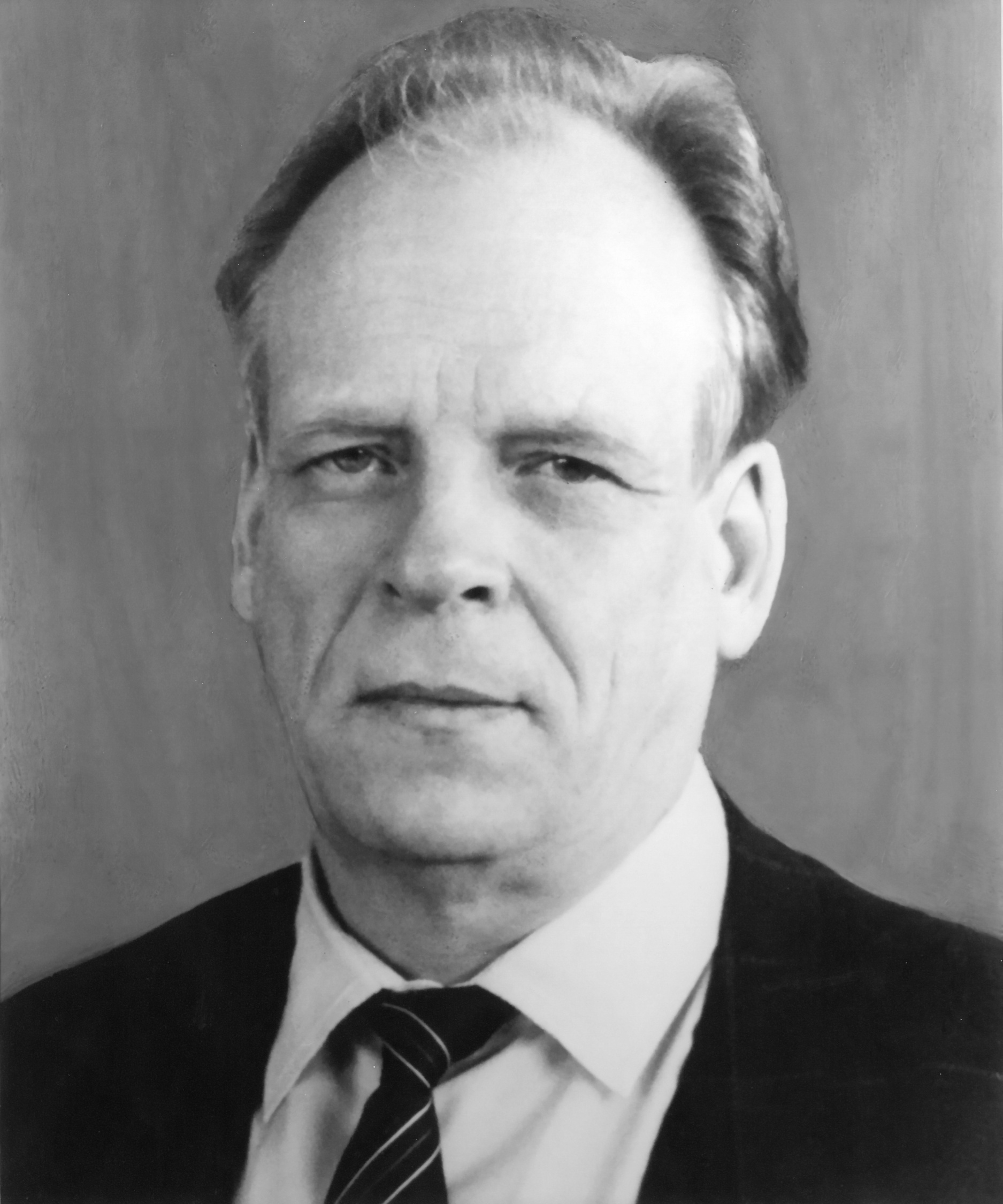
Professor Emeritus Juhani Kakkuri, former Director General of the Finnish Geodetic Institute passed away in Helsinki on August 6, 2022. He was 88 years old, born in Kurikka in the Southern Ostrobothnia region of Finland on September 12, 1933.
Juhani Kakkuri’s life and career
Juhani Kakkuri lived his childhood in Kurikka. He moved to Helsinki for the upper secondary school because such a school was not available in Kurikka at the time. Studies continued at the University of Helsinki in geophysics and physics. During summer breaks, he had employed at the Geodetic Institute, FGI, as a clerk and assistant on field work expeditions of levelling and triangulation. That initiated his lifelong career. After receiving his MSc degree from the University of Helsinki in 1960, he started as a civil servant in FGI and retired 38 years later as the Director General of the FGI.
Kakkuri’s PhD dissertation in 1973 was on stellar triangulation, the principle of which academician Yrjö Väisälä, Kakkuri's teacher, had already presented in the 1940s. The method enabled the measurement of large triangular networks using flashlights lifted in the stratosphere with weather balloons. Flashes were photographed against the starry sky using Schmidt-Väisälä type telescopes and timed using a quartz clock. Kakkuri with his team measured a network of five points in Southern Finland. The side lengths of the triangles were more than 200 km, and the closing error of a triangle was only 0.68”. At the same time, optical satellites became available, thus allowing the establishment of the first global geodetic network.
Measuring the distance of satellites using a laser had become possible in the 1970s. In 1974, Kakkuri received a scholarship from the French government, which enabled him to familiarize himself with this new technique in France. As a result of the visit, Northern Europe's first satellite laser ranging system was built at Metsähovi in 1978 in cooperation with FGI, the Helsinki University of Technology, the Tuorla observatory and the VTT Technical Research Centre of Finland. Precise technology to receive LORAN signals, necessary to measure time, was developed at FGI and the Helsinki University of Technology. This development benefited the entire country, as Yleisradio, Finland’s public broadcasting company, based its time signal broadcasts on the signals of the quartz clock locked on LORAN signals.
It was the beginning of the Metsähovi geodetic research station, which today is one of the core stations of the global geodetic network. Throughout his career, Kakkuri sought to develop Metsähovi's operations. He also supervised several dissertations.
Kakkuri participated for decades in the activities of the International Association of Geodesy, IAG. In the 1990’s he was leading the IAG Special Study Group “The Baltic Sea Level Project”. It was a joint effort of all the countries around the Baltic Sea with three large GPS campaigns. The ambitious goals of the Project were the unification of vertical datums to contribute to the determination of the gravity field and the geoid in the Baltic Sea region, to determine the sea level and sea surface topography of the Baltic Sea, and to monitor postglacial rebound, especially in the sea area. As secretary of the project, Markku Poutanen prepared his PhD thesis under the supervision of Juhani Kakkuri.
Kakkuri held several national and international positions of trust, e.g. as a representative of the International Union of Geodesy and Geophysics in New York at the meetings of the UN Cartographic Office. In addition, the cooperation between Finland and China in the field of geodesy and geosciences occurred as a result of his engagement.
Kakkuri was an honorary professor at Wuhan University and an honorary doctor at Stuttgart University, a member of the German Geodetic Commission, a member of the Finnish Academy of Science and Letters and the Finnish Academy of Technology, and was awarded the Palmén medal of the Geophysical Society of Finland for his meritorious work. He was a Fellow of IAG, and asteroid 3597 Kakkuri is named after him.
After retirement, Kakkuri wrote several popular science books, travelogues about his extensive and extraordinary travels, and biographies of his predecessors Veikko Heiskanen and T.J. Kukkamäki. His last work was the autobiography "Memoirs from the world of geodesy", published in the series of FGI in 2021.
Until the end of his life, Kakkuri was interested in science and he was a familiar sight at the Geodetic Institute, where he had his own work area for his activities. In the coffee room, he was eager to share his life wisdom from his career with the younger generation of researchers and inspired them to pursue careers in geodetic sciences with his supportive and insightful mentorship.
Before his career in the FGI, Kakkuri also considered a career as a painter. He lived some years as a subtenant of painter Lassi Tokkola, who taught him painting. Kakkuri did not become a painter, but the hobby remained throughout his life. In his free time, he painted several portraits of his friends and colleagues.
Markku Poutanen
Heidi Kuusniemi
Juhani the Friend and Humanist, by Gérard Lachapelle, Professor Emeritus, University of Calgary
My first encounter with Juhani was in October 1972 when I arrived in Finland to study at the famous Finnish Geodetic Institute (FGI) while registered as a graduate student at the University of Helsinki. I had learned about FGI from one of my professors at Laval University in Québec City, Professor Louis Joncas, with whom I had taken a one-student undergraduate course on precise geodetic measurements on Saturday mornings during my last semester. He often told me about FGI’s world leading activities in areas such as the establishment of geodetic baselines for triangulation and other geodetic infrastructure. This triggered my interest and he graciously introduced me by letter to Professor T.J. Kukkamäki, Director of FGI at the time, who responded positively to my desire to study with such experts.
I met Juhani on my first day at the Institute and listened with great interest to his explanation of his doctoral research on stellar triangulation. In the process, he introduced me to the work of the famous Väisälä brothers and scientists, Yrjö and Vilho. The former had passed away months prior to my arrival after having sown the ideas of stellar triangulation in the 1940s. Juhani and I became friends immediately. A few weeks later, he invited me to join him during nighttime star photography at the sites chosen for his research. Since the observations required clear sky conditions, much time was spent waiting, which gave us the opportunity to converse on a wide variety of subjects. Fortunately, cold winter nights were familiar to me, and strong Finnish coffee and other beverages kept us warm and alert. It was during these nights that I learned much about the history of Finland, Scandinavia and of course, the Russian Empire and its successor, the Soviet Union. Finland’s independence from the Soviet Union in December 1917 led to the creation of FGI a year later.
Juhani was a humanist and much interested in people and their culture, both in space and time, which sparked an interest that led him to travel the world later in his life. He always held positive views of countries regardless of their short-term behavior and made efforts to understand their history and achievements - and how events shaped them - a quality much needed in our complex world. His wise observations of the world were impressive and influenced mine. During these times, he introduced me to his home and lovely wife Ulla, and children Leila and Juha. Juhani was very proud of his family and was a dedicated partner and father. Many happy hours were spent at their home during weekends, which involved discussions on countless topics.
The 1973 mid-Summer Night in Finland remains a memorable experience. Juhani’s home included a Sauna of course, which we used and enjoyed frequently. In Winter 1973, we drove to his native Kurikka during a Winter storm and dangerous driving conditions, another characteristic with which I was familiar. His parents were most welcoming. Juhani introduced me to the Winter Sauna at -25˚C, including a traditional roll in the snow, which was a truly unforgettable experience. The year 1973 was special for Juhani as he completed his research and was awarded his doctorate at the University of Helsinki. This was a great career achievement and led to him becoming Director of the FGI four years later.
Following my departure from Finland in December 1973 and arrival at the Technical University at Graz for my doctoral studies, Juhani and I kept in frequent contact and I had the pleasure of hosting him during a long weekend in Graz during which we continued our conversations on science and other subjects.
We visited each other numerous times after my return to Canada in 1975, first in Ottawa and then in Calgary. After his doctorate, Juhani was able to start pursuing a variety of interests in people, science and art. On a Summer trip to Canada in the late 70s, I took him to my native birth place in Québec where he indulged in collecting butterflies. In the 80s and 90s, we met several times in Finland, Canada and at geodetic conferences around the World. My wife Elizabeth, daughter Sara and myself had the pleasure of staying with him at his home during the 1990 FIG conference held in Helsinki, which provided us with the opportunity of enjoying each other’s company. During that time, Juhani took the time to renew a long interest in oil painting and created many impressive works, including paintings of our two children which hang proudly in our home and reminds us of him. From the 1980s onward, Juhani indulged in people and culture by travelling the world, often attending geodetic conferences at the same time. Listening to his experiences and observations were always an anticipated pleasure. We hosted him a few times in Calgary in the 80s and 90s and were able to show him and his daughter Leila the Canadian Rockies in the late 90s. This was his last trip to Canada.
We had the chance to meet several times during my attendance at conferences and other meetings in Finland during the past 20 years, the last time in 2016 during the GNSS conference at Finlandia House in Helsinki. It was always a pleasure and after 30+ years, nothing had changed and we were transported back in our minds to the early 70s. Juhani never ceased his intellectual activities. During the past decade when travel became inconvenient, he indulged in another passion, namely writing. His books included “Surveyor of the Globe – Story of the Life of W.A. Heiskanen”, a person who had a tremendous impact on geodesy and the author with Helmut Moritz of “Physical Geodesy”, the most influential book in geodesy of the 20th Century, and “A Precise Man – The Life of T.J. Kukkamäki”, another accomplished man who made fundamental contributions to refraction in the 1930s, a hero of World War II, and Director of FGI for 15 years during the transformative 1960s and 70s. Juhani’s “Memoirs from the World of Geodesy”, which was published last year, is a strong testimony of the amazing accomplishments of this remarkable person.
Juhani’s son Juha said that his father was lucid to the very end, did not want to impose on anyone and passed away peacefully in his home. He will be greatly missed by family, friends and colleagues from around the world.
Gerd Boedecker (1944-2022)
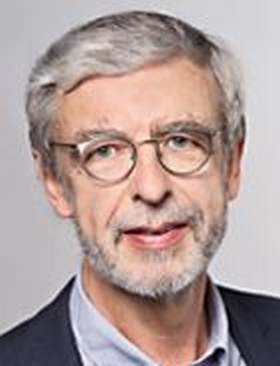
Gerd Boedecker has passed away. He died after a short illness on June 20, 2022, at the age of 78. Gerd was a very active, internationally known, and recognized scientist in the field of gravimetry.
Gerd Boedecker grew up on a farm close to the German coast of the North Sea. He studied geodesy at the Leibniz University in Hanover where he received his Ph.D. in 1975 under the supervision of Professor Wolfgang Torge. Throughout his scientific career, he kept close contact with his alma mater. In 1976 he went to the German Geodetic Research Institute and two years later he moved to the Geodesy Commission, both then at the Bavarian Academy of Sciences and Humanities. He coordinated the work of this latter commission until his retirement in 2008.
The focus of his work was on observing the spatial and temporal variations of the Earth’s gravity field with utmost precision. These measurements were used for interpretations in the field of geodynamics and the detection of temporal mass variations. Of particular importance were his contributions to gravity networks on the national, European, and global level. This work was done in cooperation with European colleagues, often under the umbrella of the International Association of Geodesy (IAG).
Since the 1990s he worked with inertial systems and later focused his research on the development of an airborne gravimeter. In a small team at the Bavarian Academy of Sciences and Humanities, he developed a prototype strapdown airborne gravimeter system that combined high-precision kinematic GNSS positioning with velocity and acceleration determination from inertial sensors. The instrumentation was designed for applications on small aircrafts flying at low altitudes with relatively low speed, thus improving the resolution of the gravity field as compared to solutions from classical airborne gravimetry. He developed all elements of this prototype system, from theory to software to its actual realization and testing. Gerd secured several important ideas with national and international patents. Gerd Boedecker held an honorary professorship at the Technical University in Munich. The students in his class enjoyed the fieldwork in gravimetry and in particular test flights with the airborne gravimeter. Due to his retirement, the development did not reach the stage of an operational airborne gravimeter.
Gerd Boedecker was active in several working and study groups of IAG. He was a very intriguing and pleasant colleague who was always interested in scientific exchange. We will keep him in good memory.
München, September 20, 2022
Christian Gerlach
Reiner Rummel
Christof Völksen
The IAG Newsletter is under the editorial responsibility of the Communication and Outreach Branch (COB) of the IAG. It is an open forum and contributors are welcome to send material (preferably in electronic form) to the IAG COB (newsletter@iag-aig.org). These contributions should complement information sent by IAG officials or by IAG symposia organizers (reports and announcements). The IAG Newsletter is published monthly. It is available in different formats from the IAG new internet site: http://www.iag-aig.org.
Each IAG Newsletter includes several of the following topics:
- news from the Bureau Members
- general information
- reports of IAG symposia
- reports by commissions, special commissions or study groups
- symposia announcements
- book reviews
- fast bibliography
| DOCUMENTS |
| IAG_Newsletter_Aug-Sep_2022.pdf |
